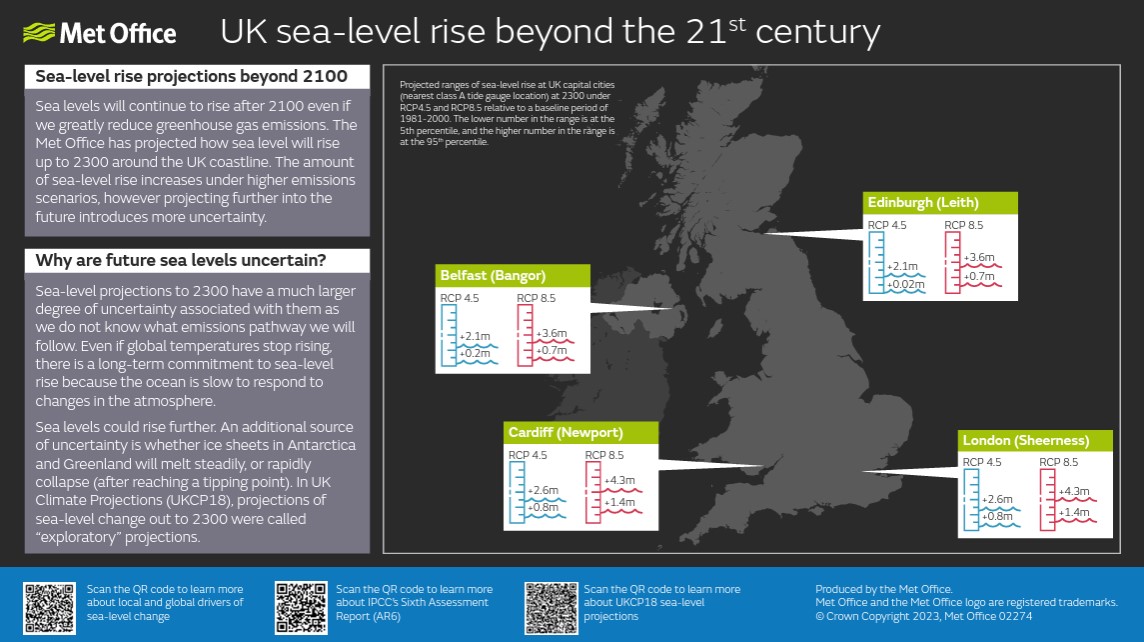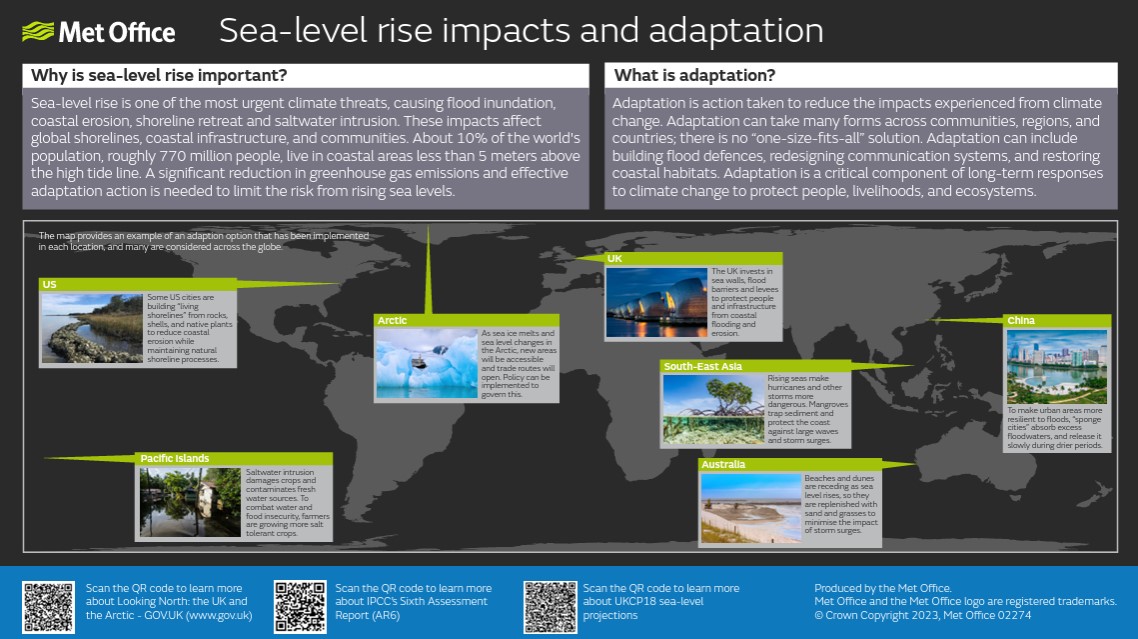Assessing the impact of future sea-level change
The Met Office Projecting Future Sea Level (ProFSea) tool generates sea-level projections to assess the impact of future sea-level change on coastal regions.
Assessing the impact of future sea-level change with the Projecting Future Sea Level tool
The Met Office Projecting Future Sea Level (ProFSea) tool generates sea-level projections to assess the impact of future sea-level change on coastal regions. This information can be used by communities to make informed decisions around adaptation, increasing their resilience to future climate risk.
Over the next century, global sea levels are on average projected to rise due to climate change. However, on a regional scale, sea-level change may differ from the global average due geophysical and environmental factors that vary from place to place determine sea-level change. Regionally sea levels will rise in most areas, remain relatively flat in some places, and even fall in a few places.

Fig 1.Projected sea-level change over the 21st century at coastal locations across the world. From Palmer et al., (2020)
Improved understanding
To better understand how sea-level rise will change in different regions, Scientists at the Met Office Hadley Centre for Climate Science and Services have developed the Met Office Projecting Future Sea Level (ProFSea) tool which can generate sea-level projections for locations across the world.
Local sea-level projections can be used to assess the impact of future sea-level rise on coastal regions. By using this information within climate services, communities can make informed decisions and be better prepared for the future climate risk to stay safe and thrive.
The Met Office ProFSea tool is an output from the successful delivery of the UK Climate Resilience Programme, Climate Service Pilot on Improving Coastal Resilience. This pilot also produced projected extreme sea levels around the UK coastline, including England, Wales, Scotland, Northern Ireland, and Isle of Man, which can be accessed on UKCP Portal. The coastal resilience service used sea-level projections produced by the ProFSea tool and combining these with other relevant data such as surge and wave data assessed the importance on future coastal risk.
Since this pilot, the Met Office ProFSea tool has been successfully used to deliver a variety of projects to support and build climate resilience and enhance decision making:
-
Assessed sea-level risks for Ministry of Defence sites at home and overseas, supporting UK Defence to meet the challenge of climate change. Read the full report: Ministry of Defence Climate Change and Sustainability Strategic Approach.
-
Local sea-level projections generated for Fiji, the Solomon Islands and Vanuatu as part of the CommonSensing project.
-
As part of the Arctic Tactical Fund project, local sea-level projections were generated for ten tide gauge locations along the three main shipping routes within the Arctic, to assess the impact of climate change on port access in the region.
The Met Office ProFSea tool provides local sea-level projections derived from climate model simulations of the Coupled Model Intercomparison Project Phase 5 (CMIP5) for the future emissions scenarios used in the Intergovernmental Panel on Climate Change’s 5th Assessment Report (IPCC AR5). Within the UK these sea-level projections are based on the methods described in the UKCP18 Marine Report, whereas for all other locations globally these are based on methods described in Exploring the Drivers of Global and Local Sea-Level Change Over the 21st Century and Beyond (Palmer et al (2020)). Several extensions to the IPCC AR5 methodology have been applied and are documented in the associated user guidance supplied alongside the tool.
The ProFSea tool and related documentation is available on GitHub. In addition, sea-level projections around the UK are included on the Met Office Climate Data Portal, where you can explore and download our climate datasets in a range of file formats.
Sea-level rise infographics
We have developed a selection of resources about sea-level rise. The infographics show how and why sea-levels will change around the world, and in the UK up to 2010 and beyond. They also explain why sea-level rise is important and show various examples of how adaptation has been implemented in various global locations.
-
‘Understanding sea-level change’ infographic (Download the ‘Understanding sea-level change’ infographic (PDF format))

-
UK sea-level rise up to 2100’ infographic (Download the ‘UK sea-level rise up to 2100’ infographic (PDF format))

-
‘UK sea-level rise beyond 2100’ infographic (Download the ‘UK sea-level rise beyond 2100’ infographic (PDF format))

-
‘Sea-level rise and impacts’ infographic (Download the ‘Sea-level rise impacts and adaptation’ infographic (PDF format))



